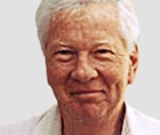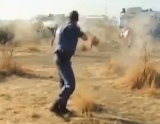One of the biggest problems with quantum experiments is the seemingly unavoidable tendency of humans to influence the situation and velocity of small particles. This happens just by our observing the particles, and it has quantum physicists frustrated. To combat this, physicists have created enormous, elaborate machines like particle accelerators that remove any physical human influence from the process of accelerating a particle's energy of motion.
Still, the mixed results quantum physicists find when examining the same particle indicate that we just can't help but affect the behavior of quanta -- or quantum particles. Even the light physicists use to help them better see the objects they're observing can influence the behavior of quanta. Photons, for example -- the smallest measure of light, which have no mass or electrical charge -- can still bounce a particle around, changing its velocity and speed.
This is called Heisenberg's Uncertainty Principle. Werner Heisenberg, a German physicist, determined that our observations have an effect on the behavior of quanta. Heisenberg's Uncertainty Principle sounds difficult to understand -- even the name is kind of intimidating. But it's actually easy to comprehend, and once you do, you'll understand the fundamental principle of quantum mechanics.
Imagine that you're blind and over time you've developed a technique for determining how far away an object is by throwing a medicine ball at it. If you throw your medicine ball at a nearby stool, the ball will return quickly, and you'll know that it's close. If you throw the ball at something across the street from you, it'll take longer to return, and you'll know that the object is far away.
The problem is that when you throw a ball -- especially a heavy one like a medicine ball -- at something like a stool, the ball will knock the stool across the room and may even have enough momentum to bounce back. You can say where the stool was, but not where it is now. What's more, you could calculate the velocity of the stool after you hit it with the ball, but you have no idea what its velocity was before you hit it.
This is the problem revealed by Heisenberg's Uncertainty Principle. To know the velocity of a quark we must measure it, and to measure it, we are forced to affect it. The same goes for observing an object's position. Uncertainty about an object's position and velocity makes it difficult for a physicist to determine much about the object.
Of course, physicists aren't exactly throwing medicine balls at quanta to measure them, but even the slightest interference can cause the incredibly small particles to behave differently.
This is why quantum physicists are forced to create thought experiments based on the observations from the real experiments conducted at the quantum level. These thought experiments are meant to prove or disprove interpretations -- explanations for the whole of quantum theory.
In the next section, we'll look at the basis for quantum suicide -- the Many-Worlds interpretation of quantum mechanics.
The Many-Worlds Theory

The quantum suicide thought experiment is based on and seeks to prove what has become an increasingly accepted interpretation of quantum physics, the Many-Worlds theory. This theory was first proposed in 1957 by a doctoral student at Princeton University named Hugh Everett III. The theory was scorned for decades until fellow Princetonian Max Tegman created the quantum suicide experiment, which lends support to the interpretation [source: The Guardian].
According to the Many-Worlds theory, for each possible outcome to an action, the world splits into a copy of itself. This is an instantaneous process Everett called decohesion. It's kind of like a choose-your-own-adventure book, but rather than choosing between either exploring the cave or making off with the treasure, the universe splits in two so that each action is taken.
One vital aspect of the Many-Worlds theory is that when the universe splits, the person is unaware of himself in the other version of the universe. This means that the boy who made off with the treasure and ends up living happily ever after is completely unaware of the version of himself who entered the cave and now faces great peril, and vice versa.
This is the same case with quantum suicide. When the man pulls the trigger, there are two possible outcomes: the gun either fires or it doesn't. In this case, the man either lives or he dies. Each time the trigger is pulled, the universe splits to accommodate each possible outcome. When the man dies, the universe is no longer able to split based on the pulling of the trigger. The possible outcome for death is reduced to one: continued death. But with life there are still two chances that remain: The man continues living or the man dies.
When the man pulls the trigger and the universe is split in two, however, the version of the man who lived will be unaware that in the other version of the split universe, he has died. Instead he will continue to live and will again have the chance to pull the trigger. And each time he does pull the trigger, the universe will again split, with the version of the man who lives continuing on, and being unaware of all of his deaths in parallel universes. In this sense, he will be able to exist indefinitely. This is called quantum immortality.
So why aren't all of the people who have ever attempted to kill themselves immortal? What's interesting about the Many-Worlds interpretation is that according to the theory, in some parallel universe, they are. This doesn't appear to be the case to us, because the splitting of the universe isn't dependent on our own life or death. We are bystanders or observers in the case of another person's suicide, and as observers we're subject to probability. When the gun finally went off in the universe -- or version -- we inhabit, we were stuck with that result. Even if we pick up the gun and continue shooting the man, the universe will remain in a single state. After all, once a person is dead, the number of possible outcomes for shooting a dead person is reduced to one.
But the Many-Worlds theory stands in contradiction to another quantum theory, the Copenhagen interpretation. In the next section, we'll look at this theory and see why it changes the rules of quantum suicide.
The Implications of Quantum Physics
When compared to classical science and Newtonian physics, the theories proposed to explain quantum physics seem insane. Erwin Schrödinger himself called his cat experiment "quite ridiculous" [source: Goldstein, Sheldon]. But from what science has been able to observe, the laws that govern the world we see every day don't hold true on the quantum level.
Quantum physics is a relatively new discipline, dating back only to 1900. The theories that have been posed on the subject are all just theories. What's more, there are competing theories that give different explanations for the peculiar happenings that take place on the quantum level. Which one will history show is the correct one? Perhaps the theory that proves to be the true explanation for quantum physics hasn't been posed yet. The person who poses it may not have even been born yet. But given the logic that this field of study has established, is it possible that all theories explaining quantum physics are all equally true at the same time -- even the ones that contradict each other?
Niels Bohr's Copenhagen interpretation of quantum physics is perhaps the most comforting theory put forth. By explaining that particles exist in all states at once -- in coherent superposition -- our understanding of the universe is put slightly askew, but still remains somewhat comprehensible. Bohr's theory is additionally comforting because it makes us humans the cause for an object to take a determined shape. Although scientists find a particle's ability to exist in more than one state frustrating, our observations affect the particle. At least it doesn't continue to exist in all states while we're looking at it.
Much less comforting is Everett's Many-Worlds interpretation. This theory takes out of our hands any power over the quantum universe. Instead, we are merely passengers of the splits that take place with each possible outcome. In essence, under the Many-Worlds theory, our idea of cause and effect goes out the window.
This makes the Many-Worlds interpretation somewhat disturbing. If it's true, then in some universe parallel to the one we currently inhabit, Adolf Hitler was successful in his campaign to conquer the world. But in the same token, in another universe, the United States never dropped atomic bombs on Hiroshima andNagasaki.
The Many-Worlds theory also certainly contradicts the idea of Occam's razor, that the simplest explanation is usually the correct one. Even stranger is the implication by the Many-Worlds theory that time doesn't exist in a coherent, linear motion. Instead, it moves in jumps and starts, existing not as a line, but as branches. These branches are as numerous as the number of consequences to all of the actions that have ever been taken.
It's tough not to imagine what our understanding of the quantum world will prove to be. The theoretical field has already progressed tremendously since its inception more than a century ago. Although he had his own interpretation of the quantum world, Bohr may have accepted the later theory that Hugh Everett introduced concerning the Many Worlds. After all, it was Bohr who said, "Anyone who is not shocked by quantum theory has not understood it."











